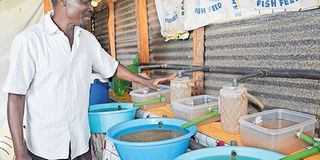Solar-run fish farm

George Muga explains a point on fish farming in his farm in Kendu Bay. A trained accountant, Muga went into fish farming about two decades ago with a starting capital of about Sh22,000, which he had saved from his salary. PHOTO | LEOPOLD OBI | NMG
What you need to know:
- Muga, a fish farmer who runs a hatchery in Kendu Bay, Homa Bay County, is able to keep his pond water fresh without incurring any electricity bills.
- From this simple innovation, the 48-year-old farmer is able to hatch more than 100,000 tilapia fingerlings a month. He sells each at fry stage at Sh5 and Sh7 for five-gram fingerlings.
- To construct the hatchery and housing unit measuring 5m by 4m, Muga spent about Sh65,000. The eggs take three to four days to hatch.
- Muga, who is also the chairman of the Homa Bay Multipurpose Aquaculture Sacco that trains its 300 members on fish production techniques, says that a major challenge in tilapia farming is predators.
George Muga places a solar panel outside his compound and inclines it towards the sun’s direction.
He then connects the panel to a generator, which is further wired to a water pump.
Thereafter, he switches the generator on and then the pump and water from a nearby river starts flowing into his fish pond.
Muga, a fish farmer who runs a hatchery in Kendu Bay, Homa Bay County, is able to keep his pond water fresh without incurring any electricity bills.
From the river, the water passes through a bio-filter made from a jerrycan that is half-filled with sand and gravel.
The pebbles help purify the water to remove impurities before it goes into his improvised recirculating aquaculture system that he uses to hatch the fish. The factory-made system goes for millions of shillings, with the price having risen recently due to taxes.
“The fish eggs in the hatchery need constant flow of clean water. To maintain high quality water, the improvised bio-filtration system removes impurities.”
From this simple innovation, the 48-year-old farmer is able to hatch more than 100,000 tilapia fingerlings a month. He sells each at fry stage at Sh5 and Sh7 for five-gram fingerlings.
A trained accountant, Muga went into fish farming about two decades ago with a starting capital of about Sh22,000, which he had saved from his salary.
In 2002, few years before he ventured into fish farming as a business, he owned two small ponds measuring 10m by 10m at his home in Awach.
“I started with 500 catfish fingerlings, which I bought at Sh4 each and spent Sh20,000 to build a pond,” explains Muga.
However, as soon as word went round that he had mature fish, the farmer began receiving orders for fingerlings.
In his first harvest, he sold 200 pieces of fish at Sh200 each, pocketing Sh40,000. A business bug then hit him.
FARMERS CAN IMPROVISE
“I used to buy fingerlings from hatcheries in Kisumu, but because of shortage fuelled by cage fish farming boom, I had to wait for several days before I received my orders. Tired of such frustrations, I then decided to start my own hatchery,” he explained.
To construct the hatchery and housing unit measuring 5m by 4m, Muga spent about Sh65,000. The eggs take three to four days to hatch.

The solar panel that fish farmer, Muga, uses to supply fresh water to his hatchery. He has four fish ponds measuring 300 square metres each besides the hatchery and in each pond, the farmer stocks 1,000 tilapia that take eight months to mature. PHOTO | LEOPOLD OBI | NMG
The farmer has attended several trainings to better his knowledge in hatchery management, including one by Food and Agriculture Organisation (FAO).
“When FAO team visited my fish farm in 2014, they asked whether I had thought of nurturing fingerlings to generate more income. I gathered courage and threw myself into the hatchery business,” says Muga, who has received another training from Farm Africa and World Fish.
Today, he has four fish ponds measuring 300 square metres each besides the hatchery. In each pond, the farmer stocks 1,000 tilapia that take eight months to mature. He sells a table-size fish at Sh350 a kilo while each goes from Sh120 to Sh150.
Muga, who is also the chairman of the Homa Bay Multipurpose Aquaculture Sacco that trains its 300 members on fish production techniques, says that a major challenge in tilapia farming is predators.
In the grow-out ponds, Muga advises that it is crucial to ensure that the water has enough algae but is not polluted.
“Fish farmers need to check for over-polluted water by confirming whether it has a dark colour, or the when the fish prefers to stay at the top surface.”
Arnoud Meijberg, the team leader at Kenya Market-led Aquaculture Programme (KMAP) of Farm Africa, explains that increasing the stocking size of fingerlings to five grammes and above reduces mortality, the production cycle and the input costs.
He notes that farmers should not keep off the hatchery business because of expensive system, but can improvise like Muga and still make money.





